2006 DODGE RAM SRT-10 oil
[x] Cancel search: oilPage 5156 of 5267
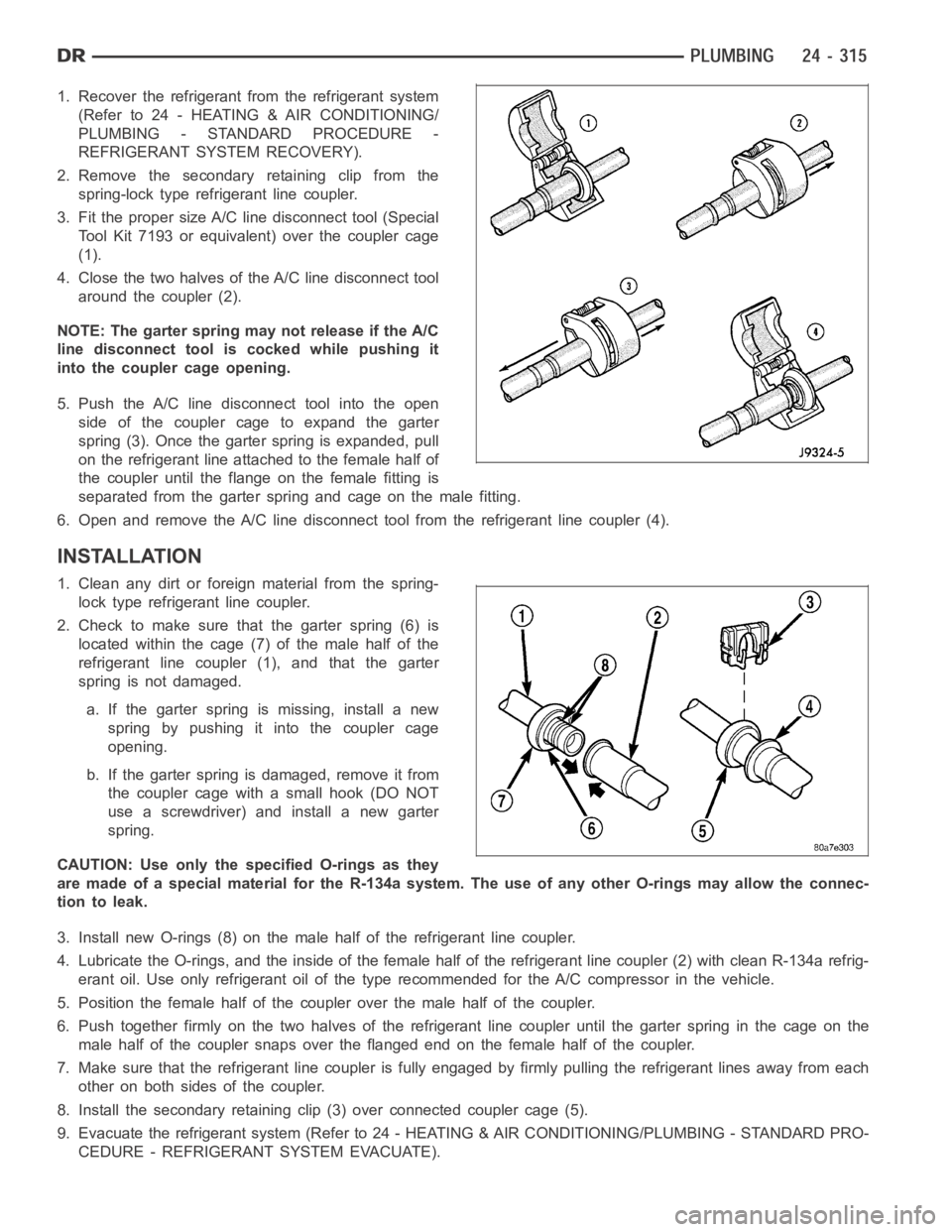
1. Recover the refrigerant from the refrigerant system
(Refer to 24 - HEATING & AIR CONDITIONING/
PLUMBING - STANDARD PROCEDURE -
REFRIGERANT SYSTEM RECOVERY).
2. Remove the secondary retaining clip from the
spring-lock type refrigerant line coupler.
3. Fit the proper size A/C line disconnect tool (Special
Tool Kit 7193 or equivalent) over the coupler cage
(1).
4. Close the two halves of the A/C line disconnect tool
around the coupler (2).
NOTE: The garter spring may not release if the A/C
line disconnect tool is cocked while pushing it
into the coupler cage opening.
5. Push the A/C line disconnect tool into the open
side of the coupler cage to expand the garter
spring (3). Once the garter spring is expanded, pull
on the refrigerant line attached to the female half of
the coupler until the flange on the female fitting is
separated from the garter spring and cage on the male fitting.
6. Open and remove the A/C line disconnect tool from the refrigerant line coupler (4).
INSTALLATION
1. Clean any dirt or foreign material from the spring-
lock type refrigerant line coupler.
2. Check to make sure that the garter spring (6) is
located within the cage (7) of the male half of the
refrigerant line coupler (1), and that the garter
spring is not damaged.
a. If the garter spring is missing, install a new
spring by pushing it into the coupler cage
opening.
b. If the garter spring is damaged, remove it from
the coupler cage with a small hook (DO NOT
use a screwdriver) and install a new garter
spring.
CAUTION: Use only the specified O-rings as they
are made of a special material for the R-134a system. The use of any other O-rings may allow the connec-
tion to leak.
3. Install new O-rings (8) on the male half of the refrigerant line coupler.
4. Lubricate the O-rings, and the inside of the female half of the refrigerant line coupler (2) with clean R-134a refrig-
erant oil. Use only refrigerant oil of the type recommended for the A/C compressor in the vehicle.
5. Position the female half of the coupler over the male half of the coupler.
6. Push together firmly on the two halves of the refrigerant line coupler until the garter spring in the cage on the
male half of the coupler snaps over the flanged end on the female half of the coupler.
7. Make sure that the refrigerant line coupler is fully engaged by firmly pulling the refrigerant lines away from each
other on both sides of the coupler.
8. Install the secondary retaining clip (3) over connected coupler cage (5).
9. Evacuate the refrigerant system (Refer to 24 - HEATING & AIR CONDITIONING/PLUMBING - STANDARD PRO-
CEDURE - REFRIGERANT SYSTEM EVACUATE).
Page 5158 of 5267
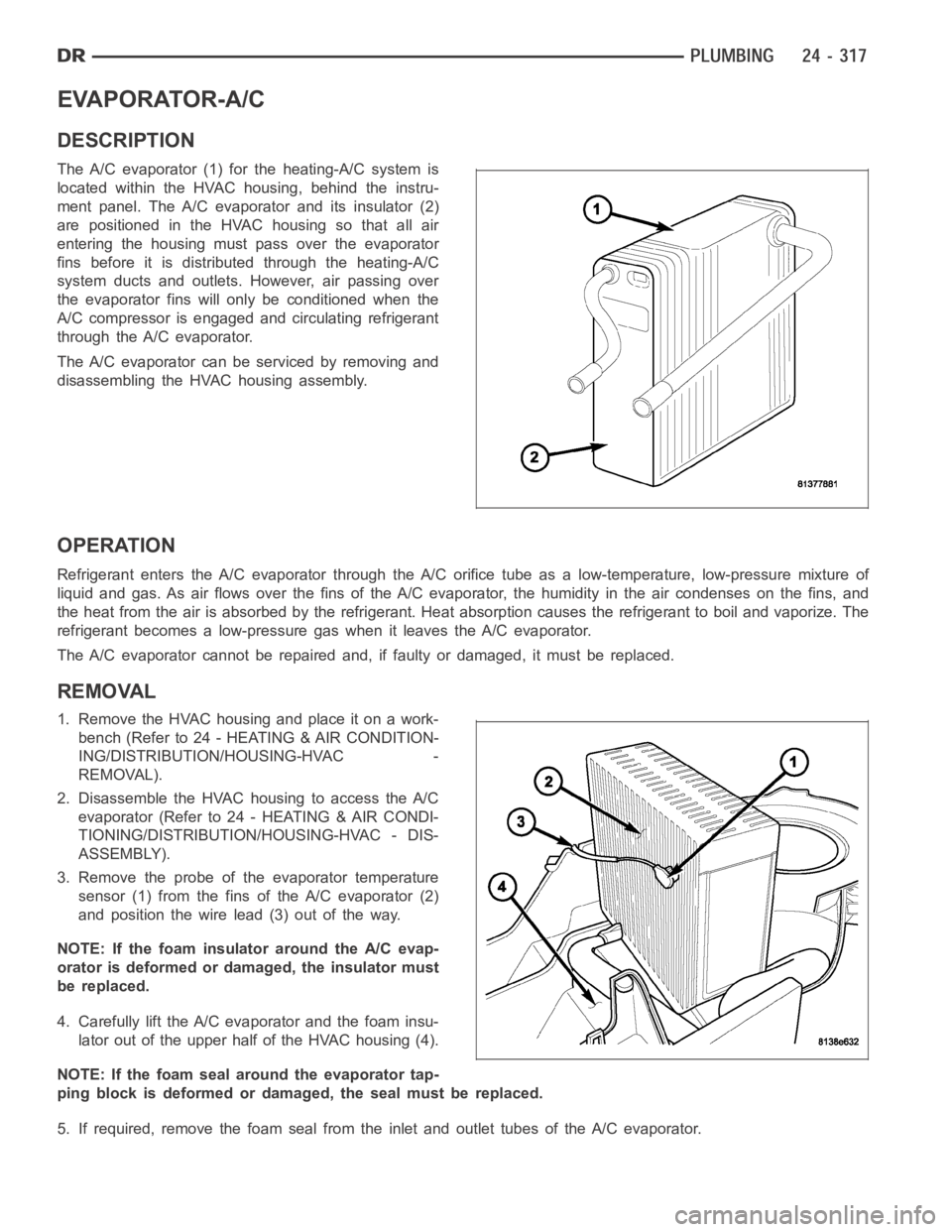
EVAPORATOR-A/C
DESCRIPTION
The A/C evaporator (1) for the heating-A/C system is
located within the HVAC housing, behind the instru-
ment panel. The A/C evaporator and its insulator (2)
are positioned in the HVAC housing so that all air
entering the housing must pass over the evaporator
fins before it is distributed through the heating-A/C
system ducts and outlets. However, air passing over
the evaporator fins will only be conditioned when the
A/C compressor is engaged and circulating refrigerant
through the A/C evaporator.
The A/C evaporator can be serviced by removing and
disassembling the HVAC housing assembly.
OPERATION
Refrigerant enters the A/C evaporator through the A/C orifice tube as a low-temperature, low-pressure mixture of
liquid and gas. As air flows over the fins of the A/C evaporator, the humidity in the air condenses on the fins, and
the heat from the air is absorbed by the refrigerant. Heat absorption causes the refrigerant to boil and vaporize. The
refrigerant becomes a low-pressure gas when it leaves the A/C evaporator.
The A/C evaporator cannot be repaired and, if faulty or damaged, it must be replaced.
REMOVAL
1. RemovetheHVAChousingandplaceitonawork-
bench (Refer to 24 - HEATING & AIR CONDITION-
ING/DISTRIBUTION/HOUSING-HVAC -
REMOVAL).
2. Disassemble the HVAC housing to access the A/C
evaporator (Refer to 24 - HEATING & AIR CONDI-
TIONING/DISTRIBUTION/HOUSING-HVAC - DIS-
ASSEMBLY).
3. Remove the probe of the evaporator temperature
sensor (1) from the fins of the A/C evaporator (2)
and position the wire lead (3) out of the way.
NOTE: If the foam insulator around the A/C evap-
orator is deformed or damaged, the insulator must
be replaced.
4. Carefully lift the A/C evaporator and the foam insu-
lator out of the upper half of the HVAC housing (4).
NOTE: If the foam seal around the evaporator tap-
ping block is deformed or damaged, the seal must be replaced.
5. If required, remove the foam seal from the inlet and outlet tubes of the A/Cevaporator.
Page 5159 of 5267
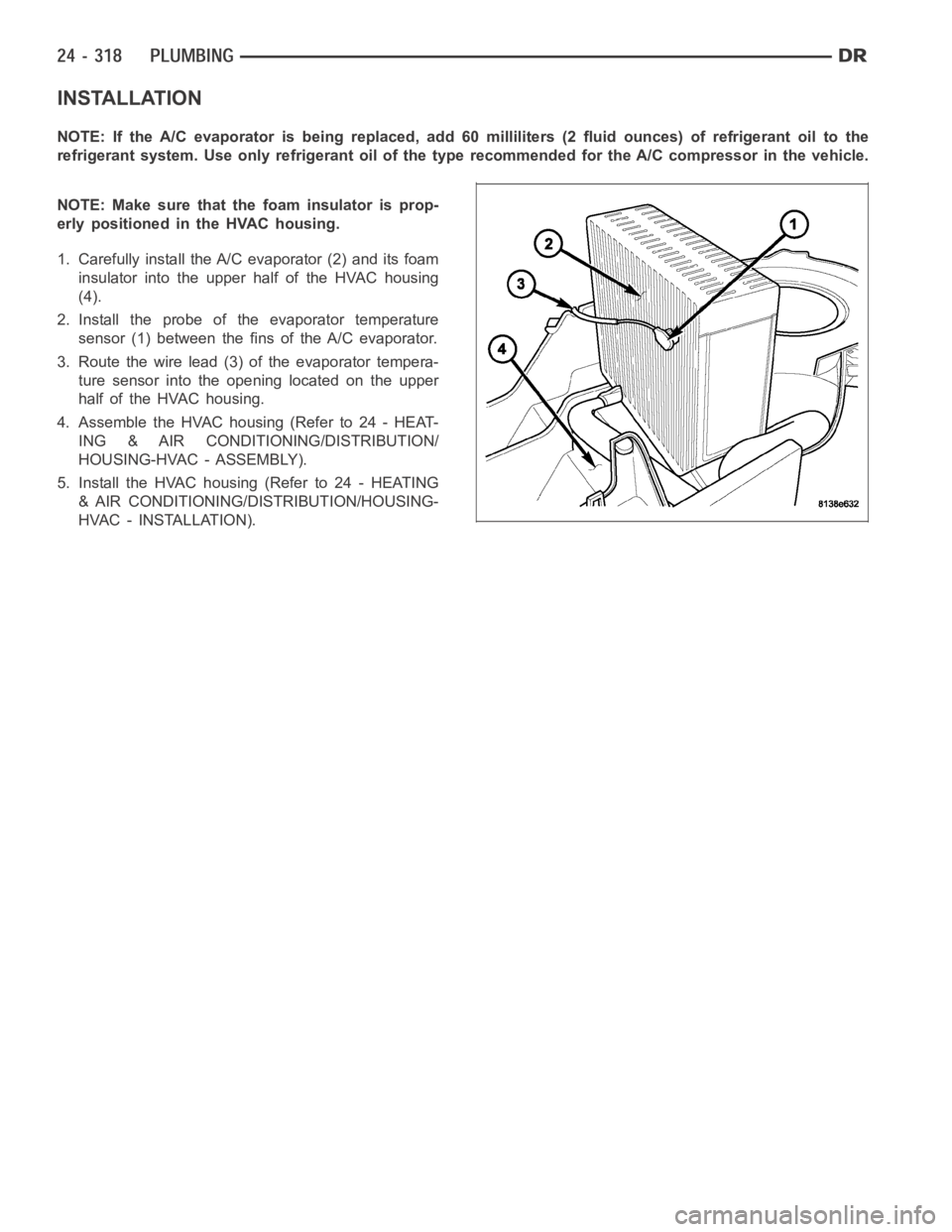
INSTALLATION
NOTE: If the A/C evaporator is being replaced, add 60 milliliters (2 fluid ounces) of refrigerant oil to the
refrigerant system. Use only refrigerant oil of the type recommended for the A/C compressor in the vehicle.
NOTE: Make sure that the foam insulator is prop-
erly positioned in the HVAC housing.
1. Carefully install the A/C evaporator (2) and its foam
insulator into the upper half of the HVAC housing
(4).
2. Install the probe of the evaporator temperature
sensor (1) between the fins of the A/C evaporator.
3. Route the wire lead (3) of the evaporator tempera-
ture sensor into the opening located on the upper
half of the HVAC housing.
4. Assemble the HVAC housing (Refer to 24 - HEAT-
ING & AIR CONDITIONING/DISTRIBUTION/
HOUSING-HVAC - ASSEMBLY).
5. Install the HVAC housing (Refer to 24 - HEATING
& AIR CONDITIONING/DISTRIBUTION/HOUSING-
HVAC - INSTALLATION).
Page 5166 of 5267
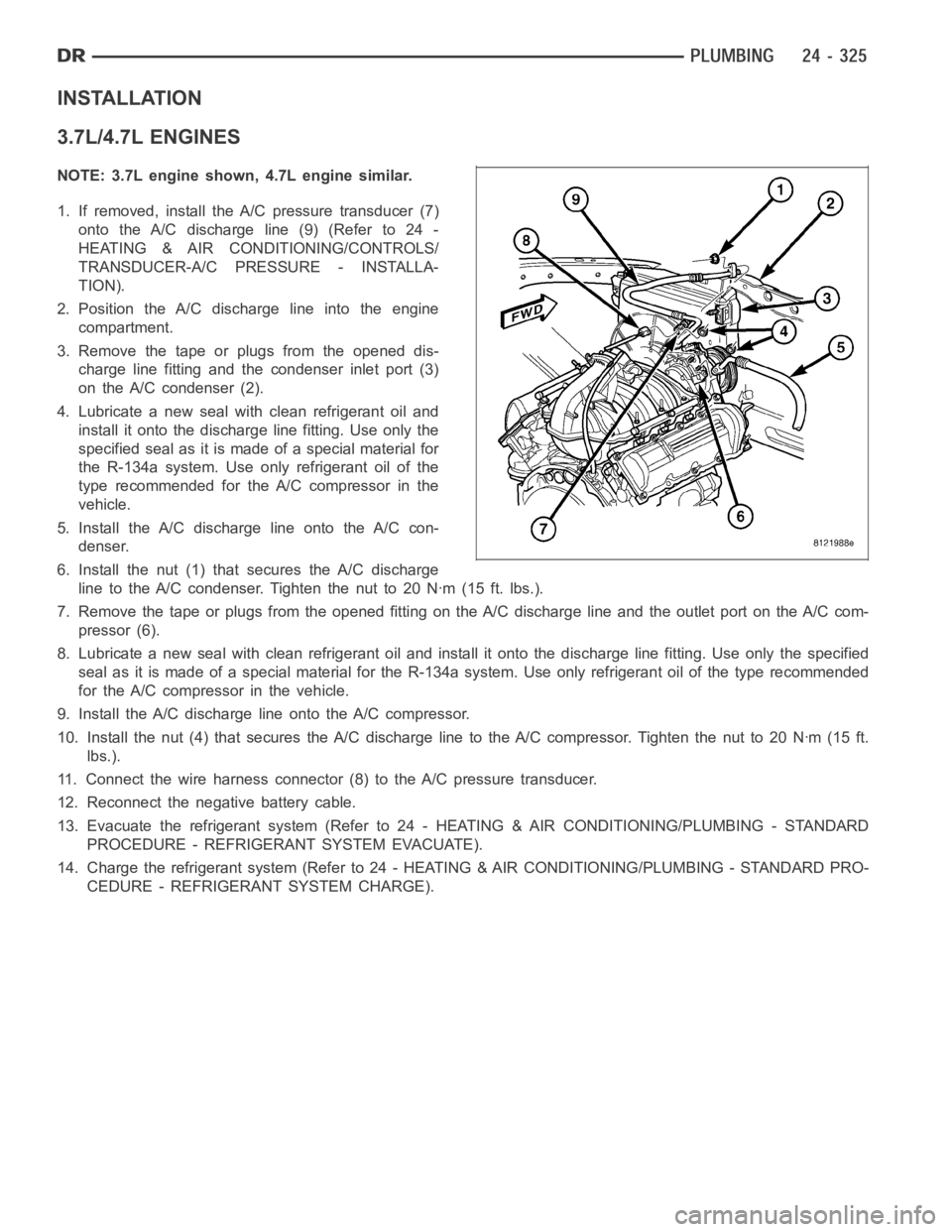
INSTALLATION
3.7L/4.7L ENGINES
NOTE: 3.7L engine shown, 4.7L engine similar.
1. If removed, install the A/C pressure transducer (7)
onto the A/C discharge line (9) (Refer to 24 -
HEATING & AIR CONDITIONING/CONTROLS/
TRANSDUCER-A/C PRESSURE - INSTALLA-
TION).
2. Position the A/C discharge line into the engine
compartment.
3. Remove the tape or plugs from the opened dis-
charge line fitting and the condenser inlet port (3)
on the A/C condenser (2).
4. Lubricate a new seal with clean refrigerant oil and
install it onto the discharge line fitting. Use only the
specified seal as it is made of a special material for
the R-134a system. Use only refrigerant oil of the
type recommended for the A/C compressor in the
vehicle.
5. Install the A/C discharge line onto the A/C con-
denser.
6. Install the nut (1) that secures the A/C discharge
line to the A/C condenser. Tighten the nut to 20 Nꞏm (15 ft. lbs.).
7. Remove the tape or plugs from the opened fitting on the A/C discharge lineand the outlet port on the A/C com-
pressor (6).
8. Lubricate a new seal with clean refrigerant oil and install it onto the discharge line fitting. Use only the specified
seal as it is made of a special material for the R-134a system. Use only refrigerant oil of the type recommended
for the A/C compressor in the vehicle.
9. Install the A/C discharge line onto the A/C compressor.
10. Install the nut (4) that secures the A/C discharge line to the A/C compressor.Tightenthenutto20Nꞏm(15ft.
lbs.).
11. Connect the wire harness connector (8) to the A/C pressure transducer.
12. Reconnect the negative battery cable.
13. Evacuate the refrigerant system (Refer to 24 - HEATING & AIR CONDITIONING/PLUMBING - STANDARD
PROCEDURE - REFRIGERANT SYSTEM EVACUATE).
14. Charge the refrigerant system (Refer to 24 - HEATING & AIR CONDITIONING/PLUMBING - STANDARD PRO-
CEDURE - REFRIGERANT SYSTEM CHARGE).
Page 5167 of 5267
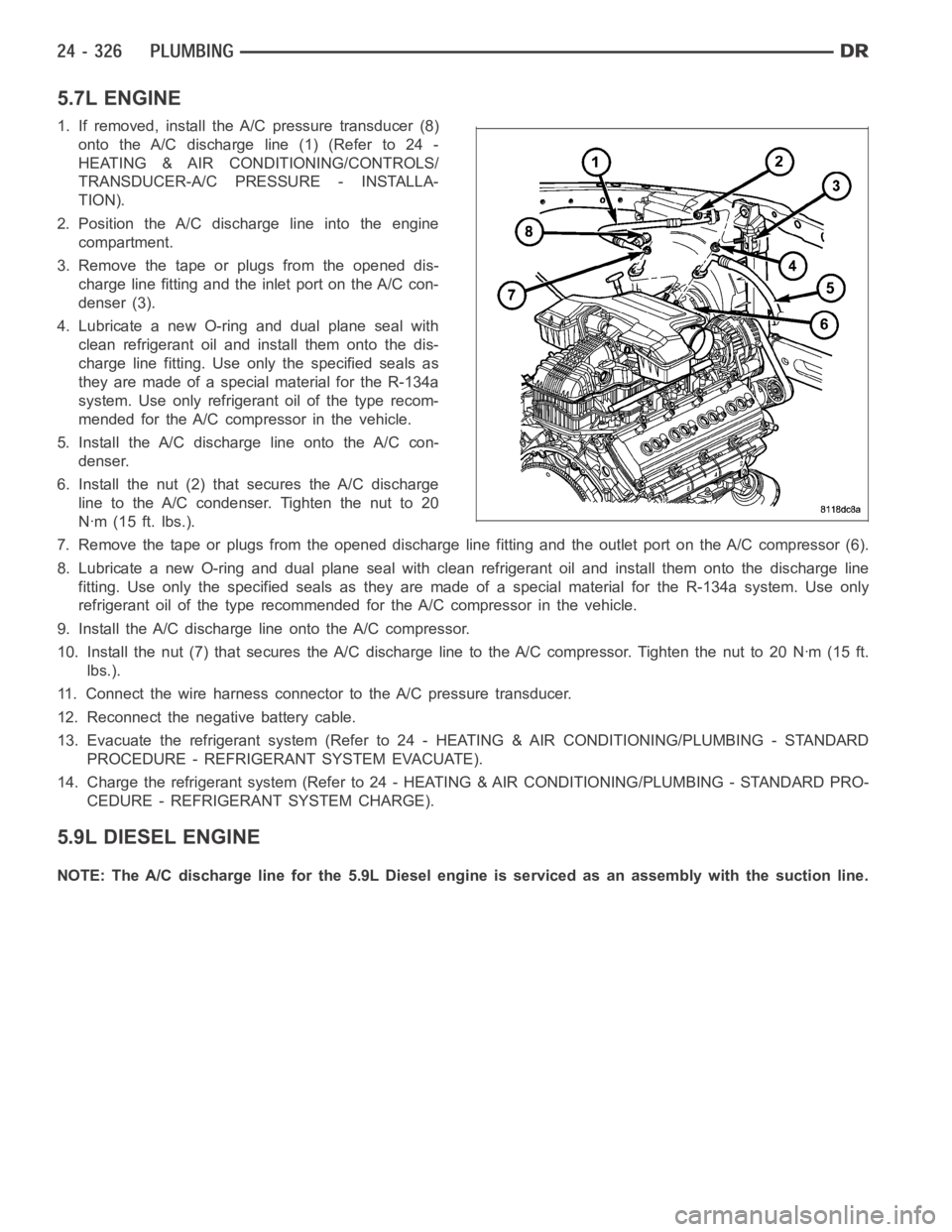
5.7L ENGINE
1. If removed, install the A/C pressure transducer (8)
onto the A/C discharge line (1) (Refer to 24 -
HEATING & AIR CONDITIONING/CONTROLS/
TRANSDUCER-A/C PRESSURE - INSTALLA-
TION).
2. Position the A/C discharge line into the engine
compartment.
3. Remove the tape or plugs from the opened dis-
charge line fitting and the inlet port on the A/C con-
denser (3).
4. Lubricate a new O-ring and dual plane seal with
clean refrigerant oil and install them onto the dis-
charge line fitting. Use only the specified seals as
they are made of a special material for the R-134a
system. Use only refrigerant oil of the type recom-
mended for the A/C compressor in the vehicle.
5. Install the A/C discharge line onto the A/C con-
denser.
6. Install the nut (2) that secures the A/C discharge
line to the A/C condenser. Tighten the nut to 20
Nꞏm (15 ft. lbs.).
7. Remove the tape or plugs from the opened discharge line fitting and the outlet port on the A/C compressor (6).
8. Lubricate a new O-ring and dual plane seal with clean refrigerant oil andinstall them onto the discharge line
fitting. Use only the specified seals as they are made of a special materialfor the R-134a system. Use only
refrigerant oil of the type recommended for the A/C compressor in the vehicle.
9. Install the A/C discharge line onto the A/C compressor.
10. Install the nut (7) that secures the A/C discharge line to the A/C compressor.Tightenthenutto20Nꞏm(15ft.
lbs.).
11. Connect the wire harness connector to the A/C pressure transducer.
12. Reconnect the negative battery cable.
13. Evacuate the refrigerant system (Refer to 24 - HEATING & AIR CONDITIONING/PLUMBING - STANDARD
PROCEDURE - REFRIGERANT SYSTEM EVACUATE).
14. Charge the refrigerant system (Refer to 24 - HEATING & AIR CONDITIONING/PLUMBING - STANDARD PRO-
CEDURE - REFRIGERANT SYSTEM CHARGE).
5.9L DIESEL ENGINE
NOTE: The A/C discharge line for the 5.9L Diesel engine is serviced as an assembly with the suction line.
Page 5168 of 5267
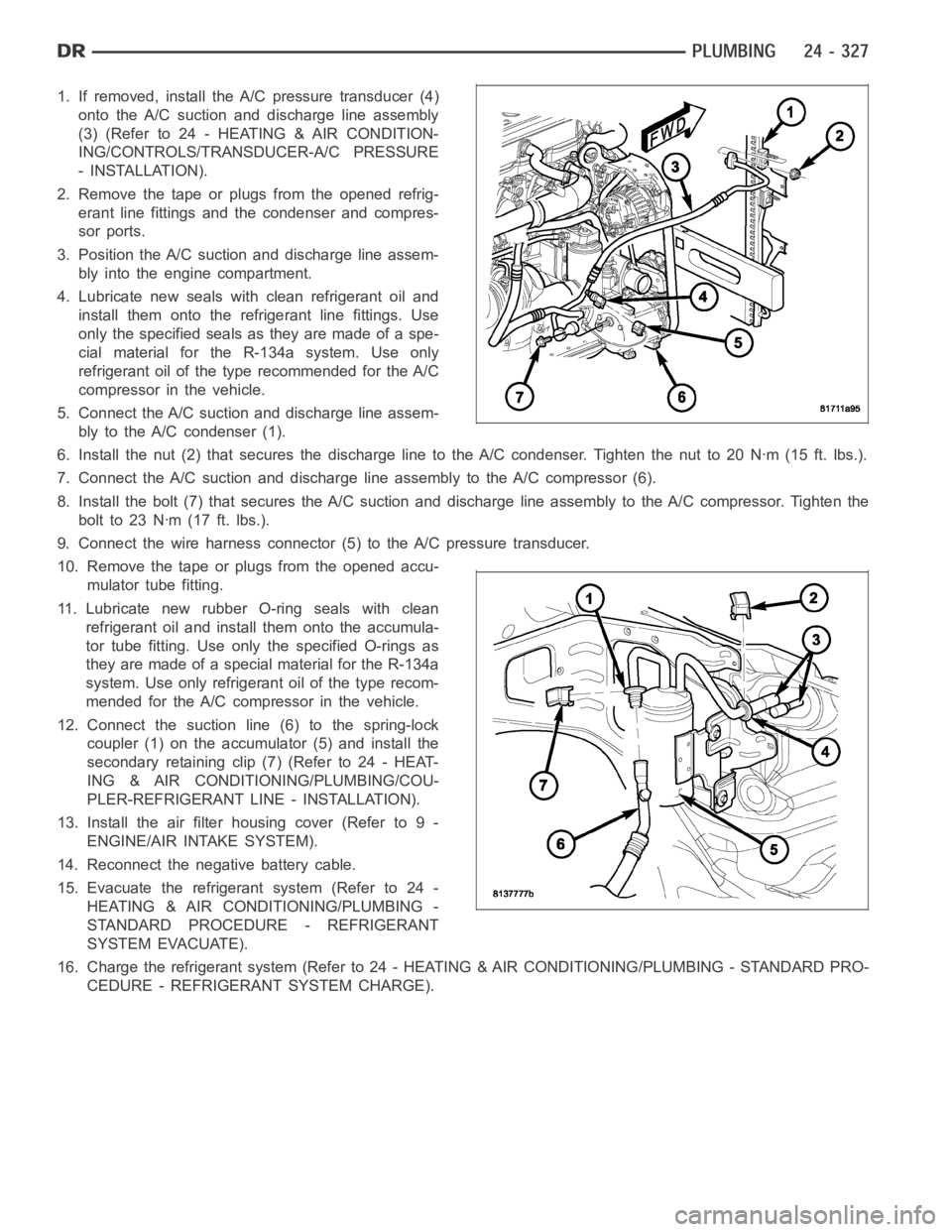
1. If removed, install the A/C pressure transducer (4)
onto the A/C suction and discharge line assembly
(3)(Referto24-HEATING&AIRCONDITION-
ING/CONTROLS/TRANSDUCER-A/C PRESSURE
- INSTALLATION).
2. Remove the tape or plugs from the opened refrig-
erant line fittings and the condenser and compres-
sor ports.
3. Position the A/C suction and discharge line assem-
bly into the engine compartment.
4. Lubricate new seals with clean refrigerant oil and
install them onto the refrigerant line fittings. Use
only the specified seals as they are made of a spe-
cial material for the R-134a system. Use only
refrigerant oil of the type recommended for the A/C
compressor in the vehicle.
5. Connect the A/C suction and discharge line assem-
bly to the A/C condenser (1).
6. Install the nut (2) that secures the discharge line to the A/C condenser.Tighten the nut to 20 Nꞏm (15 ft. lbs.).
7. Connect the A/C suction and discharge line assembly to the A/C compressor(6).
8. Install the bolt (7) that secures the A/C suction and discharge line assembly to the A/C compressor. Tighten the
boltto23Nꞏm(17ft.lbs.).
9. Connect the wire harness connector (5) to the A/C pressure transducer.
10. Remove the tape or plugs from the opened accu-
mulator tube fitting.
11. Lubricate new rubber O-ring seals with clean
refrigerant oil and install them onto the accumula-
tor tube fitting. Use only the specified O-rings as
they are made of a special material for the R-134a
system. Use only refrigerant oil of the type recom-
mended for the A/C compressor in the vehicle.
12. Connect the suction line (6) to the spring-lock
coupler (1) on the accumulator (5) and install the
secondary retaining clip (7) (Refer to 24 - HEAT-
ING & AIR CONDITIONING/PLUMBING/COU-
PLER-REFRIGERANT LINE - INSTALLATION).
13. Install the air filter housing cover (Refer to 9 -
ENGINE/AIR INTAKE SYSTEM).
14. Reconnect the negative battery cable.
15. Evacuate the refrigerant system (Refer to 24 -
HEATING & AIR CONDITIONING/PLUMBING -
STANDARD PROCEDURE - REFRIGERANT
SYSTEM EVACUATE).
16. Charge the refrigerant system (Refer to 24 - HEATING & AIR CONDITIONING/PLUMBING - STANDARD PRO-
CEDURE - REFRIGERANT SYSTEM CHARGE).
Page 5169 of 5267
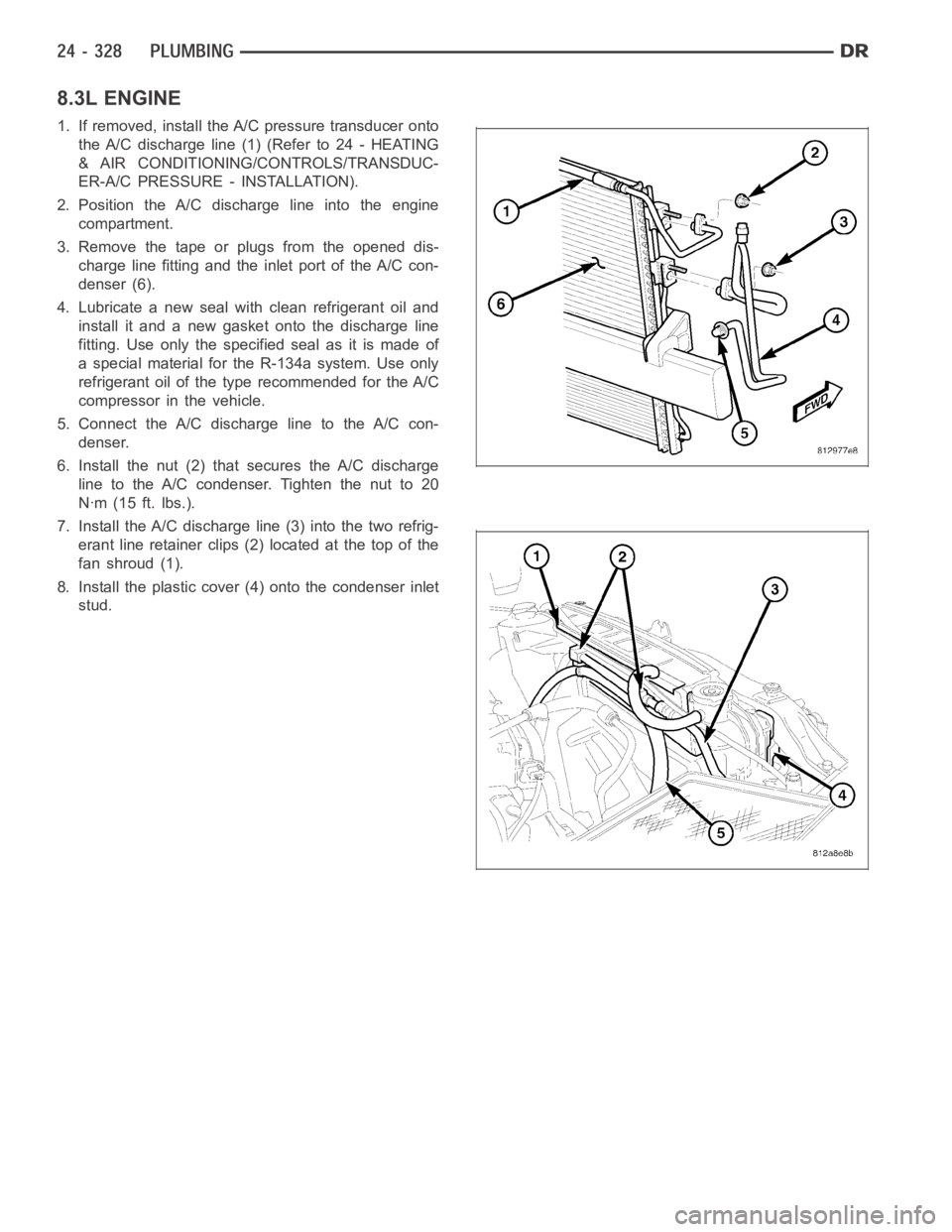
8.3L ENGINE
1. If removed, install the A/C pressure transducer onto
the A/C discharge line (1) (Refer to 24 - HEATING
& AIR CONDITIONING/CONTROLS/TRANSDUC-
ER-A/C PRESSURE - INSTALLATION).
2. Position the A/C discharge line into the engine
compartment.
3. Remove the tape or plugs from the opened dis-
charge line fitting and the inlet port of the A/C con-
denser (6).
4. Lubricate a new seal with clean refrigerant oil and
install it and a new gasket onto the discharge line
fitting. Use only the specified seal as it is made of
a special material for the R-134a system. Use only
refrigerant oil of the type recommended for the A/C
compressor in the vehicle.
5. Connect the A/C discharge line to the A/C con-
denser.
6. Install the nut (2) that secures the A/C discharge
line to the A/C condenser. Tighten the nut to 20
Nꞏm (15 ft. lbs.).
7. Install the A/C discharge line (3) into the two refrig-
erant line retainer clips (2) located at the top of the
fanshroud(1).
8. Install the plastic cover (4) onto the condenser inlet
stud.
Page 5170 of 5267
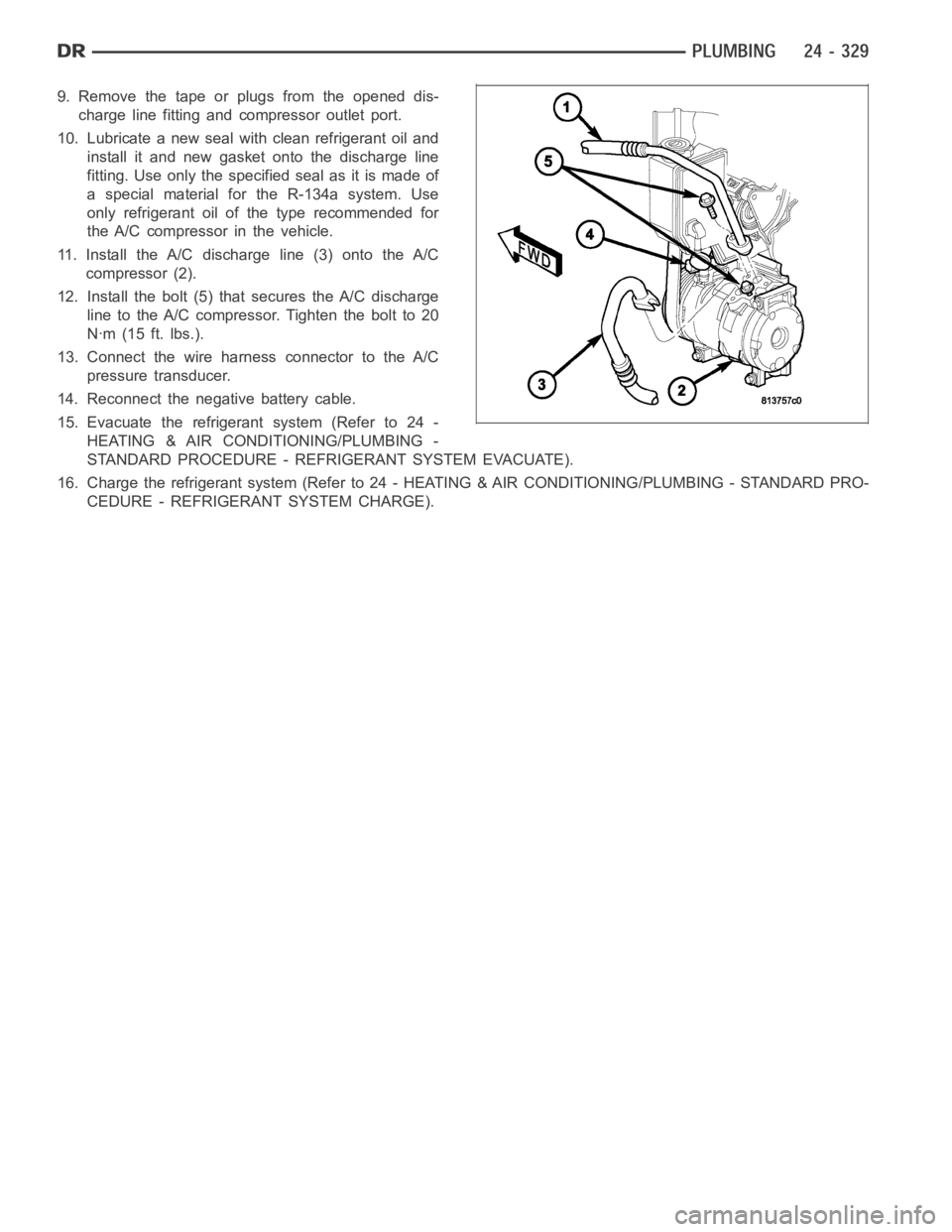
9. Remove the tape or plugs from the opened dis-
charge line fitting and compressor outlet port.
10. Lubricate a new seal with clean refrigerant oil and
install it and new gasket onto the discharge line
fitting. Use only the specified seal as it is made of
a special material for the R-134a system. Use
only refrigerant oil of the type recommended for
the A/C compressor in the vehicle.
11. Install the A/C discharge line (3) onto the A/C
compressor (2).
12. Install the bolt (5) that secures the A/C discharge
line to the A/C compressor. Tighten the bolt to 20
Nꞏm (15 ft. lbs.).
13. Connect the wire harness connector to the A/C
pressure transducer.
14. Reconnect the negative battery cable.
15. Evacuate the refrigerant system (Refer to 24 -
HEATING & AIR CONDITIONING/PLUMBING -
STANDARD PROCEDURE - REFRIGERANT SYSTEM EVACUATE).
16. Charge the refrigerant system (Refer to 24 - HEATING & AIR CONDITIONING/PLUMBING - STANDARD PRO-
CEDURE - REFRIGERANT SYSTEM CHARGE).